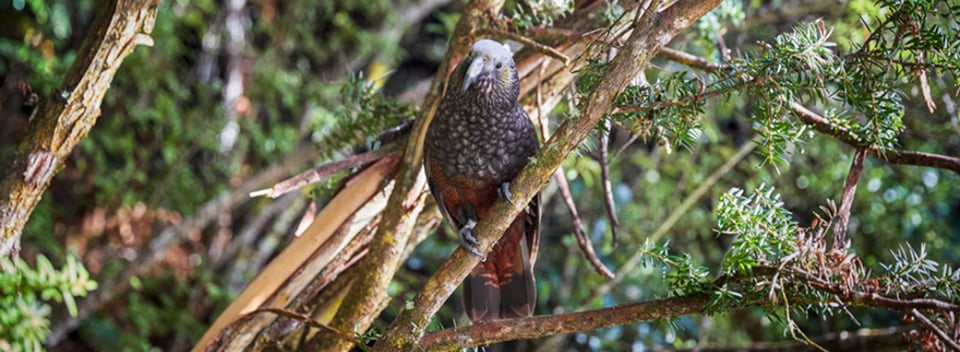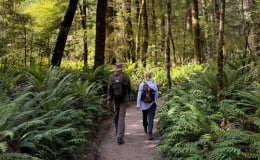
New Zealand Birds - NZ's Unique Parrots

New Zealand is home to a plethora of very unique bird species. Initially a land with no mammals (aside from one species of bat), New Zealand’s bird species were able to evolve and thrive with little predation. This led to the evolution of many flightless birds, and a diverse range of bird species unlike anywhere else in the world. Due to the introduction of mammals and pests many of our unique species have already gone extinct, while many of those that remain are at significant risk of doing so. Predatory animals such as stoats and possums are responsible for an estimated loss of 26 million native birds and their eggs each year.
This blog is part of our New Zealand Birds series. To learn more about New Zealand’s special endemic birds, check out our other blogs here.
New Zealand Parrots
Three of our favourite New Zealand birds are a unique group of parrots – the kea, kaka, and kakapo. These special parrots are a family distinct from other parrots around the world, and have lots of interesting characteristics and behaviours.
Kea
The cheeky, curious and highly intelligent kea is the only mountain parrot in the world. Lovers of anything shiny, and famous for pecking the antenna off cars, stealing your lunch and taking off with unsuspecting tourists’ car keys, these birds are full of character and truly unique. Found in alpine areas throughout the South Island (and occasionally in lowland areas), the kea are a crowd favourite with locals and tourists alike. Despite their numbers being in steady decline over recent years and the current population being estimated at around only 5000individuals, kea are frequently spotted at popular alpine hotspots. If you’re travelling over any of the road passes that cross the Southern Alps, or getting off the beaten track in the mountains, you’re very likely to hear the distinctive call of the kea, and catch a glimpse of their colourful plumage, just make sure to keep an eye on your belongings!

Kea facts:
-
Kea are the world’s only alpine parrots.
-
They get their name from their distinctive high-pitched cry which sounds like “keeee-aaaaa”
-
Kea are the largest flighted land birds in New Zealand, standing around 50cm tall, with a wingspan of over 1m.
-
Their feathers are olive-green and iridescent blue, with bright orange feathers in their underwings which are only visible when flying
-
Kea have the equivalent intelligence of a 3 year old human child and display excellent problem-solving skills.
-
A flock of kea is known as either a ‘circus of kea’ or a ‘curiosity of kea’.
-
Kea populations are now threatened not only due to introduced pests such as stoats, but were drastically influenced by hunting in the mid 1800s to mid 1900s. Following reports that kea had been attacking livestock, the New Zealand government offered a bounty for kea to protect farmers’ sheep. It is estimated that roughly 150,000 kea were shot during this hundred year period. These bounties were finally outlawed in 1971 and kea only gained full protection status in 1986.
-
Kea were declared nationally endangered in 2013.
Kaka
Kaka, kea and kakapo together form a distinct family of parrots called Strigopodae and all descend from a common ancestor. Kaka, unlike kea, inhabit lower lying forested areas rather than alpine environments. While at first glance they look similar to kea, they are smaller and are an olive-brown colour with a deep crimson belly. Similar to kea, kaka have bright red-orange underwing feathers. Kaka do not possess the same naughty characteristics of the kea and are less likely to approach humans, however that can be quite raucous and loud (particularly at dawn and dusk) and are often described as chattering and gossiping.

Kaka Facts:
-
Kaka are forest-dwelling parrots that are found on all three of New Zealand’s main islands as well as many offshore island.
-
They are significantly smaller than kea, standing at about 40cm tall and half the weight of a kea.
-
Kaka are very social and are often found in large flocks, sometimes including kea in their groups
-
Often heard before they are seen, kaka are named after their harsh, rhythmic “ka-aa” that they repeat while flying.
-
Kaka numbers are in decline in areas that are not extensively predator controlled. Populations on predator-free offshore islands are thriving, however it is estimated there are fewer than 10,000 individuals remaining throughout New Zealand and it’s offshore islands.
-
Kaka nest deep in hollow trees. This makes them easily cornered by predators such as stoats, meaning that nesting females are the most vulnerable and has resulted in a disproportionate male/female ratio.
-
Kaka, like many native New Zealand bird species, are now considered endangered.

Kakapo
The kakapo is arguably the most unique parrot in the world. Large, flightless, nocturnal and very long-living, kakapo are unlike any other species of parrot, or any bird for that matter. They are critically endangered and teetering on the brink of extinction, with their numbers plummeting to 511 kakapo in 1995. Significant conservation programs have allowed them to survive on offshore predator-free islands, but considerable ongoing efforts will be required to prevent extinction.
Kakapo Facts:
-
Kakapo are nocturnal, and the name means “night parrot” in Maori
-
At 60cm tall and weighing 3 to 4kg, kakapo are the world’s largest species of parrot.
-
While kakapo can’t fly, they do have wings. They use their short wings for balance and support, and to help “parachute” them to the forest floor after climbing trees.
-
“Freeze like a kakapo in the headlights” – kakapo developed a survival adaptation to freeze when they sense nearby danger back before mammalian predators were introduced to New Zealand. This was an effective technique when their primary predators where birds of prey, as their green plumage easily camouflaged them from above in their forest habitats. Unfortunately this is very ineffective against predators such as stoats and makes the kakapo easy pickings.
-
They are very friendly are historically were kept as pets by Maori and early European settlers. Kakapo appear to have little fear of humans and will happily climb on and preen people. George Grey, who first described the kakapo in 1845, noted this his pet kakapo behaved more like a dog than a bird.
-
Kakapo, in absence of predators, will live up to 90 years old making them one of the longest-living bird species in the world.
-
The loud booming noise made by kakapo can be heard up to 5 kilometres away. During mating season, male kakapo will make 20 to 30 of these “booms” followed by a “ching” sound for up to 8 hours a night for 2 to 3 months!
-
There are currently 211 known adult kakapo, all of which have names and are carefully monitored.
- Kakapo are now critically endangered.
New Zealand is a wonderful place to immerse yourself in the outdoors and learn about our interesting and unique native wildlife. Join one of our luxury small group tours to experience the best bits of New Zealand with a knowledgeable guide who knows all the best places to get you up close and personal with birds such as the kea, kaka and kakapo. To find out more about our tours, REQUEST A FREE COPY OF OUR BROCHURE HERE.







